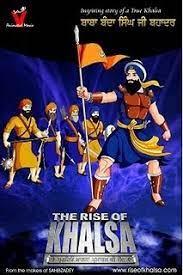The rise of the Khalsa:
The Guru was then named Gobind Singh instead of Gobind Rai. Guru Gobind Singh was the first one to take Amrit from the Khalsa, the Five Beloved Ones. About 80,000 men and women were baptized within a few days at Anandpur. "The creation of the Khalsa was the greatest work of the Guru. He created a type of superman, a universal man of God, casteless and country less. The Guru regarded himself as the servant of the Khalsa. He said, "To serve them pleases me the most; no other service is so dear to my soul." The Khalsa was the spearhead of resistance against tyranny." (Miss Pearl, S. Buck)
The creation of the Khalsa created a sense of unity among the Sikhs and their supporters. This unity and the resulting perceived strength in the Sikhs did not go well with the local rulers. The continuous gatherings at Anandpur sahib and the presence of many thousands of the congregation, some armed with fierce weapons caused anguish with the surrounding hill Rajas. These developments most alarmed the caste ridden Rajput chiefs of the Sivalik hills. They perceived the Sikhs as lower caste beings who had posed no danger to their authority. However, the creation of the Khalsa changed that. Firstly, it disturbed their system of discrimination and division; secondly, they could see that the forces of the Guru were becoming dangerous in number and in armaments.
The Guru was then named Gobind Singh instead of Gobind Rai. Guru Gobind Singh was the first one to take Amrit from the Khalsa, the Five Beloved Ones. About 80,000 men and women were baptized within a few days at Anandpur. "The creation of the Khalsa was the greatest work of the Guru. He created a type of superman, a universal man of God, casteless and country less. The Guru regarded himself as the servant of the Khalsa. He said, "To serve them pleases me the most; no other service is so dear to my soul." The Khalsa was the spearhead of resistance against tyranny." (Miss Pearl, S. Buck)
The creation of the Khalsa created a sense of unity among the Sikhs and their supporters. This unity and the resulting perceived strength in the Sikhs did not go well with the local rulers. The continuous gatherings at Anandpur sahib and the presence of many thousands of the congregation, some armed with fierce weapons caused anguish with the surrounding hill Rajas. These developments most alarmed the caste ridden Rajput chiefs of the Sivalik hills. They perceived the Sikhs as lower caste beings who had posed no danger to their authority. However, the creation of the Khalsa changed that. Firstly, it disturbed their system of discrimination and division; secondly, they could see that the forces of the Guru were becoming dangerous in number and in armaments.
The rise of the Khalsa:
The Guru was then named Gobind Singh instead of Gobind Rai. Guru Gobind Singh was the first one to take Amrit from the Khalsa, the Five Beloved Ones. About 80,000 men and women were baptized within a few days at Anandpur. "The creation of the Khalsa was the greatest work of the Guru. He created a type of superman, a universal man of God, casteless and country less. The Guru regarded himself as the servant of the Khalsa. He said, "To serve them pleases me the most; no other service is so dear to my soul." The Khalsa was the spearhead of resistance against tyranny." (Miss Pearl, S. Buck)
The creation of the Khalsa created a sense of unity among the Sikhs and their supporters. This unity and the resulting perceived strength in the Sikhs did not go well with the local rulers. The continuous gatherings at Anandpur sahib and the presence of many thousands of the congregation, some armed with fierce weapons caused anguish with the surrounding hill Rajas. These developments most alarmed the caste ridden Rajput chiefs of the Sivalik hills. They perceived the Sikhs as lower caste beings who had posed no danger to their authority. However, the creation of the Khalsa changed that. Firstly, it disturbed their system of discrimination and division; secondly, they could see that the forces of the Guru were becoming dangerous in number and in armaments.
0 Comments
0 Shares
0 Reviews




